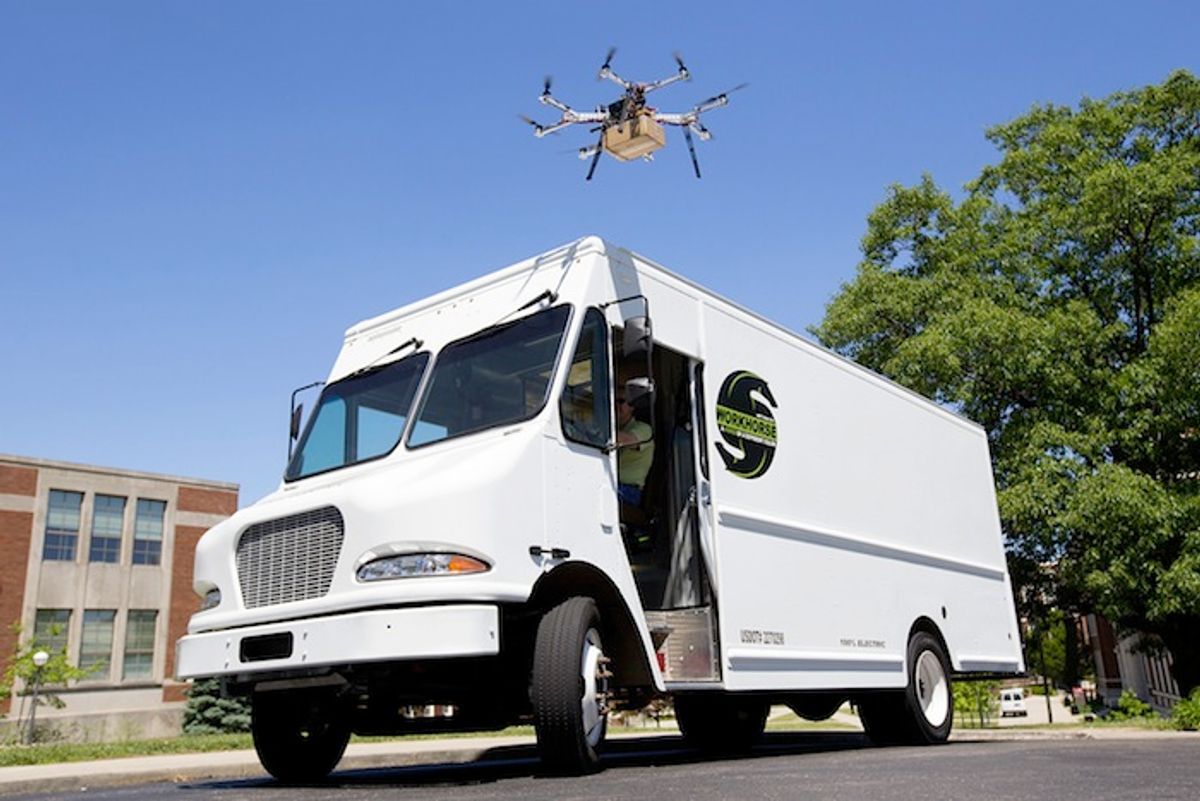Amp Holdings is a company that’s making a hybrid electric delivery truck that costs delivery companies 30 cents per mile to operate, as opposed to the dollar per mile that diesel trucks cost. That sounds like it’s a thing that’s worth buying all by itself, but Amp also wants to integrate a delivery drone (called a HorseFly) into each truck to make short deliveries semi-autonomously.
So, is using a truck as a base the way to make delivery drones work?
Amp’s HorseFly drone system has two primary differentiators to other drone delivery concepts. First, it plans to use the trucks as mobile launch and recharging bases to bring the drones (and packages) closer to their destinations, allowing each drone to carry significantly more over a shorter distance, up to 20 pounds (9 kilograms).
Second, Amp says that they’re going to deal with the biggest issue—the last few dozen meters or so—by letting remote human pilots take over for the final portion of the flight. According to Amp, this system would be safer and more efficient than Amazon’s proposed autonomous warehouse-based drones.
In the scenario Amp has in mind, the drone (or drones) would be able to make additional deliveries, using the truck as a base, than a truck (and driver) alone. It sounds great: the truck drives around delivering the heavy stuff, while the drone zips back and forth dropping off lighter packages, saving lots of time and consequently lots of money. But let’s think about what actually has to happen to pull this off.
When Amp’s HorseFly-equipped delivery truck is within range of a drone-deliverable address, the truck driver gives the package to the drone, which scans the barcode and sends the driver’s iPad a satellite image of the address. The driver then selects what looks like a reasonable location for the drone to drop the package, and the drone takes off. The driver continues on his or her route.
The first problem I see here is using a satellite image to select a delivery location. Satellite images are often out of date, and not high enough resolution to see obstacles that might pose a hazard to drones. But let’s assume there’s a backyard where the package could be dropped.
Next, the drone takes off. Amp suggests that the drone will now fly autonomously to the location selected on the satellite map, but this is where having a truck as a launch point causes problems. With a more centralized model (like taking off from a warehouse), the takeoff and high level flight probably could be automated, since you can study the area and pre-select paths free from obstacles. But with a delivery truck that’s driving around pseudorandomly, that’s not going to work: Either the driver will have to know the neighborhood well enough to select an unobstructed path or the drone will have to have autonomous sense and avoid capabilities (Amp is not doing this).
And there are more problems: Once the drone gets safely up off the delivery truck, the FAA says it can’t do what Amp wants it to do, which is fly autonomously out of line-of-sight of its controller until it reaches its preliminary delivery point. Amp has applied for an exemption, so we’ll see how that goes.
Now for the clever bit of Amp’s approach: to deal with the most unpredictable and dangerous part of this whole drone delivery business—the final approach and delivery itself—Amp is delegating this task to a remote human operator. This is a good plan, in theory. From what I can tell, Amp has not actually tried this, and it seems like one of those things that you can get to work well enough in a demo but that is probably much trickier when you try to do it in practice. Amp is likely going to have to use a cellular connection, and trying to reliably stream real-time video at a high enough resolution and low enough latency to be useful could be very difficult. Also, it of course means that there’s an added cost, since you’ve got to pay (and house) the drone pilots. For the record, the FAA says that you can’t do this, either. Again, Amp has applied for an exemption.
When the drone does make it back to the truck, the good news is that its batteries aren’t a limitation: the battery charger is wireless and only takes a few minutes to top itself up, thanks to a system developed by the University of Cincinnati (which also developed the HorseFly octocopter itself).
In summary, Amp has a creative approach to drone delivery with some significant merits to other approaches to drone delivery. But even if the FAA okays everything that Amp wants to do, I’d be very surprised if they can get their system to work in a commercially viable manner.
I’m going to end this curmugeonly drone delivery article the same way I end all of my curmogeonly drone delivery articles: I would absolutely love to be proven wrong. There are drone delivery scenarios that make sense, and work. What we need are more of those—more real and practical solutions—and less hype.
Evan Ackerman is a senior editor at IEEE Spectrum. Since 2007, he has written over 6,000 articles on robotics and technology. He has a degree in Martian geology and is excellent at playing bagpipes.



